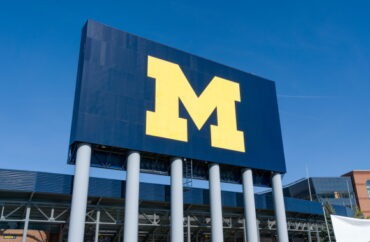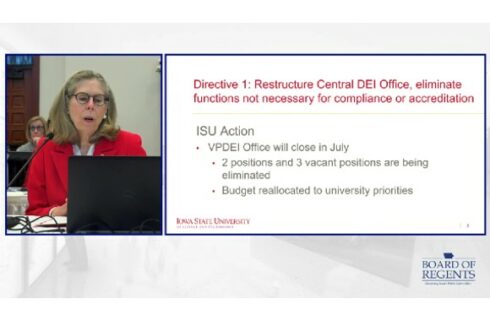
ANALYSIS: ‘UM has become a DEI ideological complex with a university attached’
The University of Michigan continues to exponentially grow the number of staffers dedicated to advancing diversity, equity, and inclusion, with at least 241 paid employees now focused on DEI and payroll costs exceeding $30 million annually, according to an analysis conducted for The College Fix.
The payroll costs are $23.24 million for salaries and $7.44 million for benefits, or $30.68 million, an amount that would cover in-state tuition and fees for 1,781 undergraduate students.
Thirteen DEI staff members earn more than $200,000 and 66 earn more than $100,000 when factoring in benefits.
In addition, 76 faculty or staff members work part-time as “DEI Unit Leads” advancing diversity efforts in one of UM’s 51 schools, colleges, and units, bringing UM’s core DEI headcount to 317, said economist Mark Perry, who conducted the analysis.
The number of positions at Michigan’s flagship university advancing DEI exceeds more than 500 when including those who work full-time or part-time on DEI and factoring in open and unfilled positions, as well as employees who serve as “DEI Unit Leads” and others who serve on dozens of DEI committees, Perry said.
“That brings the total number of UM employees who advance DEI on either a paid or unpaid basis to well more than 500 and possibly as high as 600,” said Perry, a paid consultant for The Fix who used public salary and website data for the analysis.
University of Michigan disputes the findings, arguing in a statement to The College Fix they are “flawed and misleading” since they include employees whose primary duties are not solely DEI-related.
“Diversity, equity and inclusion are core values at the University of Michigan. As such, there is not a specific budget set aside for diversity outreach and recruitment,” said Colleen Mastony, university spokesperson, in an email Monday to The College Fix.
“Most employees working on DEI are not solely dedicated to DEI efforts but do so in addition to their other roles and responsibilities.”
“…The university’s DEI efforts are appropriate to the size, scope, and complexity of our university – spanning the university, including 51 units over our three campuses, our academic medical center, and our over 100,000 students and employees. Although some work is done centrally, much of it is done at the unit and department level,” Mastony said.
Today, the public university employs at least 241 paid staff members whose main duties are to provide DEI programming and services as a primary job responsibility, according to Perry.
As part of UM’s ambitious five-year Diversity, Equity & Inclusion (DEI) 2.0 Plan, the university’s 19 academic schools and colleges and its 32 non-academic units must now also implement DEI plans. Non-academic units include the school’s three libraries, art museum, botanical gardens, IT department, athletics, development, audit services and more.
“UM’s five-year diversity central plans are reminiscent of the Soviet Union’s and Communist China’s five-year central plans to achieve ‘Ideal Communist Societies’ which are examples of top-down oppressive bureaucratic blueprints to socially engineer outcomes decided by the top leadership of the dictatorial regimes,” Perry said.
“UM has become a DEI ideological complex with a university attached,” he said, referring to Warren Buffett’s comment calling GM is a health and benefits company with an auto company attached.
The $30.68 million cost to fund the 241 DEI employees does not include indirect costs, such as computers, phones, printers, travel expenses, conference expenses and overtime.
Perry said the full number of DEI positions likely exceeds 500 when taking into account: full-time or part-time DEI staffers at 241; employees who serve as DEI Unit Leads at 76; DEI positions currently open or unassigned, roughly 130; and employees serving on dozens of DEI committees in various departments, schools, colleges, and units at 150 or more.
DEI staff is well compensated with salaries as high as $402,800 for the university’s chief diversity administrator, Tabbye Chavous Sellers. She is paid almost two times more than the average full professor, about 2.5 times more than the governor, and about three times more than the average assistant or associate professor.
Michigan’s Gov. Gretchen Whitmer’s salary is $159,300, and the average salaries for assistant, associate, and full professors at UM are $129,500, $148,300, and $206,500, respectively.
The average DEI salary at UM is $96,400; factoring in fringe benefits, 144 DEI employees at UM receive a total compensation of more than $100,000.
The 2023-24 totals are a huge increase from last year’s figures, which came in at 142 DEI employees at a payroll cost of $18 million annually, a spike that can in part be traced to UM’s recent and sweeping five-year Diversity 2.0 Plan, which “outlines UM’s diverse, inclusive future” over the next five years from 2023 to 2028.
UM’s new DEI 2.0 plan comes on the heels of its first $85 million 5-year DEI 1.0 Plan from 2016 to 2021. According to the January 2023 column “The Good, the Bad, and the Ugly of DEI 1.0” in the Michigan Review, that plan failed miserably.
The independent student newspaper reported that campus climate surveys conducted in 2016 and 2021 found that UM students became less happy since the beginning of DEI 1.0 on nearly every metric.
The survey results show “DEI 1.0 has been a failure, and it is not because of a lack of resources. If the largest number of diversicrats in the country cannot improve life on campus, there is something wrong at the heart of the effort,” argued then-student Charles Hilu.
Hilu, a former contributor to The College Fix, said last week the new figures are even more disheartening.
“Given the program’s track record, it is unfortunate that the DEI bureaucracy is ballooning even further,” he said via email.
“As I had pointed out before, nearly every measure of student well-being declined after DEI 1.0, and students became less likely to interact with their peers who had different backgrounds,” he said.
“The first effort certainly did not have a lack of resources. I hope that the University of Michigan has truly assessed why DEI 1.0 yielded the poor results it did, given the amount of money and staff they are now throwing at their diversity programs.”
MORE: Ohio State University doubled DEI staff in five years, payroll costs almost tripled
IMAGE: Ken Wolter / Shutterstock
Like The College Fix on Facebook / Follow us on Twitter





Please join the conversation about our stories on Facebook, Twitter, Instagram, Reddit, MeWe, Rumble, Gab, Minds and Gettr.